with Fiber
Reactive Dyes
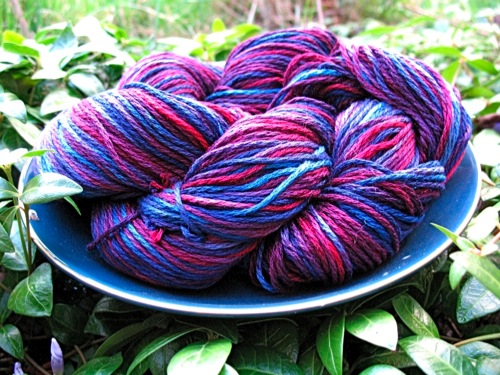  Why
should the wool people have all the dyeing
fun? Fiber reactive dyes are specifically
designed for dyeing plant fibers: cotton,
linen, rayon, hemp, ramie, bamboo - even
rattan and nettle. The dyes are safe, light
and color-fast, come in a huge rainbow of
colors, and can dye anything that originally
came from a plant. Why
should the wool people have all the dyeing
fun? Fiber reactive dyes are specifically
designed for dyeing plant fibers: cotton,
linen, rayon, hemp, ramie, bamboo - even
rattan and nettle. The dyes are safe, light
and color-fast, come in a huge rainbow of
colors, and can dye anything that originally
came from a plant.
Fiber reactive dyes are also
referred to as cold-water dyes, because they
do not require high temperatures to make the
dyes permanent: no microwaves or boiling water
required.
Unlike acid dyes, these dyes
react in an alkaline environment, and so require
the addition of a base instead of an acid to
activate the dyes. My base-of-choice is soda
ash (sodium carbonate). It's best to buy soda
ash in its pure form from a dye supplier. However
you find it, make sure it is pure and has no
additives or anti-caking agents.
Different fibers take dyes in differing amounts.
Linen will dye a slightly different color than
cotton, even if they are originally the same
color. Rayon takes dye vigorously and will
dye up in saturated colors. If you're trying
to dye a fiber a particular color, experiment
first.
The final color also depends on the original
color of the yarn. Remember yellow plus blue
makes green? If your original yarn is red and
you dye it with blue, the yarn will become
purple. Cream-colored yarn will always dye
a little duller than white yarn. If you are
looking for very bright colors, start with
a bleached white yarn.

Orange
yarn over-dyed with Fire Red, Peacock Blue,
and Plum.
You can also dye blends of
fibers, including acrylic, polyester, or protein
fiber blends. Fiber reactive dyes will NOT
dye synthetic fibers or most protein fibers.
The exception is silk, although
I prefer not to dye silk this way -- soda ash
is harsh on silk fibers and silk tends to lose
its soft hand when dyed this way. Silk shouldn't
be exposed to a soda ash solution more than
12 hours or it will begin to destroy the fiber,
so you must rinse no later than 12 hours after
dyeing. Also, fiber reactive dyes do not produce
quite the same colors on silk as they do on
cotton -- especially black, which produces
a purple, deep blue, or dark green instead.
Dye
results depend on the yarn construction and
content, but as a rule most man-made/plant
fiber blends will look heathered after dyeing
and appear much more pale than 100% plant fiber.
One special note about cotton:
cotton is sometimes treated in a process
called mercerization, which makes the fibers
sleeker, shinier, and more receptive to dye.
A mercerized cotton will dye into more brilliant
colors than non-mercerized cotton. Mercerization
is not always marked on the yarn label, but
it's usually easy to tell: mercerized cotton
will have a sheen, somewhat like silk. Non-mercerized
cotton's surface looks and feels more matte.
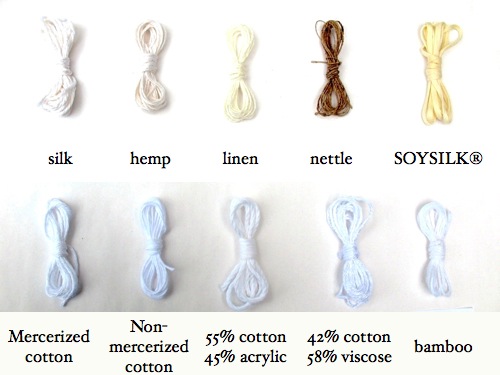
Undyed yarns
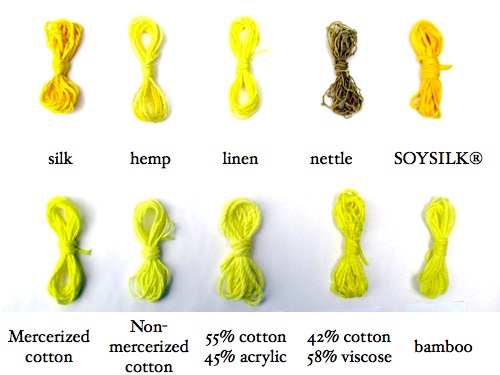
dyed
with Lemon Yellow
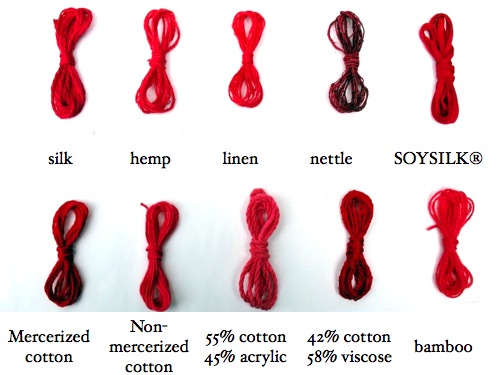
dyed with
Fire Red
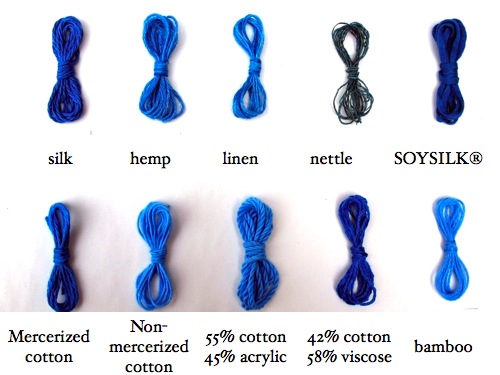
dyed with
Peacock Blue
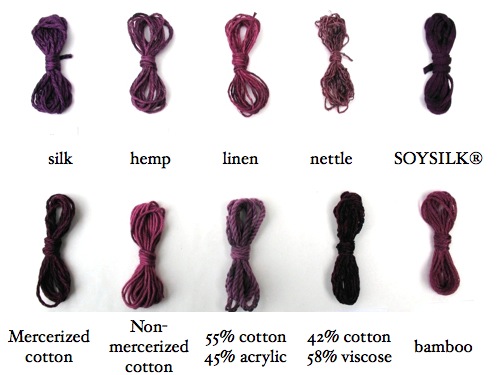
dyed with Plum
Fiber reactive dyes are considered
fairly safe to use when they are liquid form.
They are more dangerous as powder, and you
should use caution and the appropriate tools
when handling them. The dye particles are very
fine to enable them to dissolve more easily
in water, but that same property makes them
unsafe to breathe and prone to floating in
the air even with a small disturbance.
Use a dust mask when handling
the dye powder and powdered soda ash, one certified
by a government agency as safe for small particulates
(for example, in the U.S., use a dust mask
approved by NIOSH). I also recommend that when
working with the powders, you do it out of
doors: breezes can blow away fine particles
so that you do not breathe them.
Because soda ash is caustic and dyes will dye ANY
plant fiber and temporarily stain most protein
fibers, including your skin, wear goggles and
gloves while working. Lightweight disposable
latex or vinyl gloves are fine, although I
prefer heavier latex gloves because they can
be used again and again. Yes, goggles are annoying,
but spending 30 minutes rinsing your eyes out
because you splashed dye or soda ash in them is
not fun. Wear goggles.
A couple more safety things: don't use any
of your dye tools for eating or cooking, and
keep dyes away from small children and animals
- you don't know what they might do.
- Fiber reactive dyes
- soda ash
- Synthrapol
- water softener, if you have hard
water. Minerals in water can disrupt the
dye process. Dye suppliers often carry this.
- dusk
mask, certified for small particulates
- goggles
- rubber or vinyl gloves
- old clothes to wear
while dyeing, which you don't mind getting
stained
- a plastic drop-cloth to cover your work
surface
- several rags for wiping up spills
- cups or jars for mixing dyes
- measuring spoons
- measuring cup
- rinse basin - such as plastic dishwashing
container
- yarn soak basin - another plastic container
for pre-soaking the yarn
- stirring tools - I use plastic knives (spoons
don't work as well)
- gallon jug for mixing soda ash solution
- jug for water
- plastic bags for finished yarn. These should
be large enough to accommodate a skein of
yarn without the yarn edges touching.
- funnel
- yarn for tying the dye skeins.
- spray bottle full of plain water for cleanup
- Optional: dye applicators:
squeeze bottles (such as those used for hair
dyes), spray bottles, sponge-top applicators
I keep a rinse basin and
a jug of water on my work surface, and any
item I dirty (measuring cups, spoons, stirrers,
funnels, etc) I throw into the rinse basin
with some water. It simplifies cleanup and
reduces the amount of dye powder that might
be floating around in the air.

1. Prepare your yarn. Make the ball into a
hank, and then tie LOOSELY in at least 4 places
around the hank. When tying, make a figure-8
tie by bringing the tying yarn from the bottom
through the skein, over the top, through the
skein going the other directions, and tied
at the bottom.
2. Don your dusk mask and goggles, prepare
your workspace, and fill your water jug with
warm (~105 F) water (and water softener, if
needed)
3. Mix soda ash fixer solution. I use the
ratio suggested by Dharma Trading Company:
1 cup soda ash in 1 gallon hot water. Soda
ash dissolves better in hot water, and it will
have cooled to warm by the time you're ready
to dye. I use a funnel to measure the soda
ash directly into a gallon jug, fill with hot
water, cap the jug, then shake shake shake.
Add water softener if needed.
4. Once the soda ash is completely dissolved,
pour some of it into a plastic basin. Put your
prepared yarn into the basin, completely submerging
it. Let it soak for 20 minutes or more. You
can reuse this fixer solution until it runs
out.
5. Meanwhile, mix the dye
solutions.
Measure out dye into a jar or cup
that can accommodate at least a cup of liquid.
For medium colors, measure 2 teaspoons of
dye powder. Some dyes need a higher concentration
- read the manufacturer's suggestions. For
lighter colors, use less dye. For dark colors,
use more dye.
For safety, I immediately close the powder
containers as soon as I'm finished measuring
the powder. I then wipe off the outside of
the powder container and dye cup with a wet
rag, to catch any powder that might be clinging
to the sides.
After measuring out the powder, add a very
small amount of warm water (1/2 teaspoon or
so). Use a stirrer to mix the powder and water
until it makes a paste. Add a little more water
and thin out the paste. Finally, add a cup
of warm water, in stages, stirring to dissolve
the powder. If you're using sealable jars,
you can put the lid on and shake it to mix
the solution.
6. Transfer dyes to applicator bottles, if
you choose. Bottles allow finer control over
dye placement, but you can also just pour directly
from the dye jars.
7. Remove yarn from the fixer solution and
squeeze out the extra liquid. Lay out the yarn
on your workspace.
8. Pour, spray, or squeeze dye onto the yarn.
Remember the color
wheel! If you place 2 colors next to each
other which are complimentary (opposites
side of the color wheel: e.g. red & green,
purple & yellow, blue & orange) they
will make BROWN. In general, unless you're
dyeing a rainbow, it's easiest to stick to
only 2 or 3 colors.
A note here: plant
fibers require MUCH more dye than protein
fibers. With acid dyeing, most of the dye
reacts and you're left with a clear or
slightly colored solution. Not so with
fiber reactive dyes - a lot of dye will
be left over even when the yarn is finished.
You need to apply more dye than you expect,
or you will get spots of undyed or under-dyed
yarn.
Once you've finished applying a dye, squeeze
the dyed yarn a bit so that the dye is transferred
through the entire cross section of the skein.
Otherwise, the yarn in the middle will be lighter
in color than the outer yarn. Less squeezing
= more color variegation.
9. Transfer the skein to a plastic bag, arranging
the skein so that differently-colored parts
of the yarn do not touch each other. Tie the
bag closed and leave in a warm place (at least
65 F/18 C). You need the yarn to stay wet and
warm for at least 12 hours, and preferably
24.
10. After 12-24 hours
(12 hours for pastels and silk, 24 for deeper
colors), open the bag and rinse out the
yarn with COLD WATER. Cold water removes
extra dye without causing it to react. You
must wash out all of the soda ash and most
of the extra dye. This part can be tedious,
there will be a lot of extra dye to rinse
out.
Dye can be rinsed out into a sewer system
without worry - it's not toxic. The soda ash
solution is weaker than most chemicals used
to unblock drains. The dyes WILL stain the
sink for a while, so use an outside hose or
a utility sink if you can.
11. After rinsing until
the water runs clear, I recommend you give
the skeins a final wash in Synthrapol, a
detergent and dye magnet. If there are any
unreacted dye molecules still on your skein,
it latches on to them, and keeps them from
staining other things they will touch. Synthrapol
requires hot water, and it will not work
if there is soda ash still in the yarn (hence
all the rinsing in the previous step). Follow
the manufacturer's directions for the Synthrapol
wash. After rinsing out the Synthapol, squeeze
out any extra liquid and hang the skein to
dry in a place away from the sun.
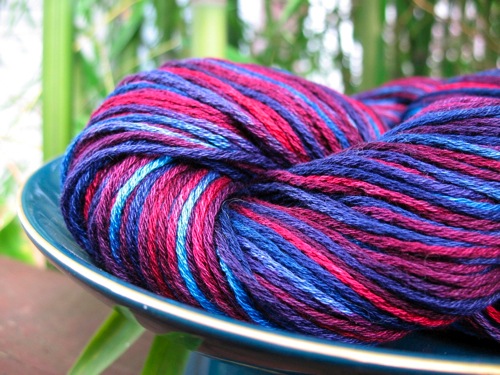
The dye solutions can be used for the next
couple weeks; they will gradually fade in intensity.
After two weeks I dump dye solutions down the
sink and mix up new ones. The soda ash fixer
can be kept indefinitely.
One more thing you should know about fiber
reactive dyeing: soda ash is caustic and it
will degrade fibers over time. You don't want
to leave your yarn exposed to it for a long
time. It's particularly hard on silk, which
is why I prefer to use acid dyes on silk. Because
of this, sometimes the dye process will change
the hand of the fiber, so that it feels rougher
after dyeing. If this bothers you, most dye
suppliers sell commercial-strength fabric softeners
which will re-soften the fibers.
Dye suppliers
Dharma
Trading Co
All dyes used in this article were Dharma's
Procion MX Fiber Reactive dyes.
Dye, supplies, and even un-dyed yarn.
Pro
Chemical & dye:
Also carries Fiber Reactive Procion MX dyes
and all dye supplies
References
Dharma
Trading Co
Their website contains many useful tutorials
and suggestions.
Paula
Burch's All About Hand Dyeing:
Paula has been dyeing fabric for many years
and this site is full of great information.
There is an emphasis on fabric, but most
of this can also be applied to yarn. |

